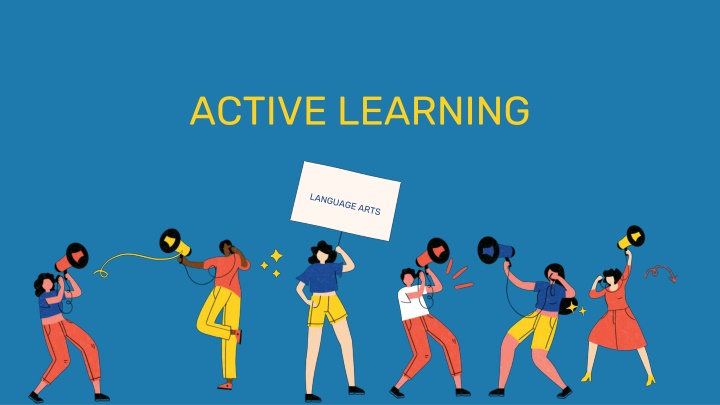
Active Learning Process and Benefits
Active learning places student learning at its core, emphasizing engagement, critical thinking, and reflective learning. Constructivism theory and Bloom's Taxonomy support the idea of learners constructing their knowledge for deeper understanding. By fostering autonomy and lifelong learning skills, active learning encourages students to actively engage with materials, generate meaning, and reflect on their learning experiences.
Download Presentation

Please find below an Image/Link to download the presentation.
The content on the website is provided AS IS for your information and personal use only. It may not be sold, licensed, or shared on other websites without obtaining consent from the author. If you encounter any issues during the download, it is possible that the publisher has removed the file from their server.
You are allowed to download the files provided on this website for personal or commercial use, subject to the condition that they are used lawfully. All files are the property of their respective owners.
The content on the website is provided AS IS for your information and personal use only. It may not be sold, licensed, or shared on other websites without obtaining consent from the author.
E N D
Presentation Transcript
WHAT IS ACTIVE LEARNING ? Active learning is a process that has student learning at its centre. Active learning focuses on how students learn, not just on what they learn. Students are encouraged to think hard , rather than passively receive information from the teacher. Students should be encouraged to be actively engage in learning in a reflective way.
WHAT IS THE THEORY BEHIND ACTIVE LEARNING? Constructivism - Learners construct or build their own understanding knowledge and understanding in order to achieve deeper levels of understanding and develop their existing Bloom s Taxonomy- learners are more able to analyse, evaluate and synthesise ideas and achieve the higher order skills
Active learning fosters students 1 learning and their autonomy WHAT ARE THE BENEFITS OF ACTIVE Active learning encourages success and engagement 2 LEARNING? Active learning helps students to become 'lifelong learners 3
Misconceptions about active learning Active learning is all about doing a particular activity 'Active learning means taking away the teacher s influence 'Active learning means a complete change of teaching style 'Students have to be physically active Active learning makes students less respectful
Active learning Active learning aims to promote: active engagement with materials and resources, with ideas, and perhaps with other people active sense-making standing back from the experience reflecting to create knowledge, extracting meaning and consequences (summarised in the sequence What? So what? Now what? )
How to apply active learning into practice? Choose strategies that can engage every learner actively into the learning Provide opportunity to think hard, reflect and apply real life
Example of active learning: Reading Student book XII, Module I Study and Work , Unit 3: Jobs and Society Exercise 2a, page 46 Artificial Intelligence: Does it mean boom or doom for your career? Ask your students to follow the questions before, while after reading the text. Plan: Skim the text, what s it about? What do I already know? What do I want to know? Do: Read, with the above questions in mind Review: Ask what s the message? , what do I think? Learn: Summarise the main idea or points. Explain to someone Apply: Predict what will happen next, if these ideas are taken forward
Example of active learning: Writing Example of active learning: Writing essay Plan: brainstorm the idea, clarify the purpose Do: create a draft Review: reread, review your work Learn: consider the feedback provided Apply: redraft and publish Student book XII, Module I Study and Work , Unit 3: Jobs and Society Exercise 5. page 62. Writing a composition about your future plan 1. Brainstorm the ideas using the questions provided: What will you do after high school? Will you study or work? Will you take international exams such as IELTS, TOEFL iBT? Do you want to take English or any online courses? Will you have gotten any certificate or diploma after 5 and 6 years? Are you interested in a full time or part time job? Are you planning to work with people or work alone? 2. Answer the questions 3. Review your work 4. Provide feedback or ask peers to provide feedback 5. improve the writing for final submission
Reference Wadsworth, B. J. (1996). Piaget s Theory of Cognitive and Affective Development. New York: Longman. Wood, D., Bruner, J. S. and Ross, G. (1976). The Role of Tutoring in Problem Solving. Journal of Child Psychology and Psychiatry, 17, 89 100. Available online at: https://onlinelibrary.wiley.com/doi/epdf/10.1111/j.1469- 7610.1976.tb00381.x Information on Cambridge professional development qualifications can be found at: www.cambridgeinternational.org/pdq Getting Started with Active Learning, Getting Started with Evaluating Impact and Getting Started with Metacognition are available at: www.cambridgeinternational.org/gettingstarted
